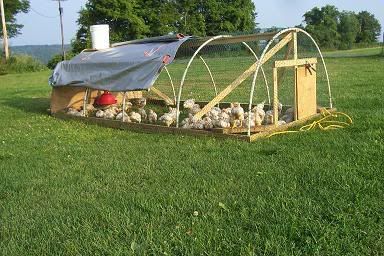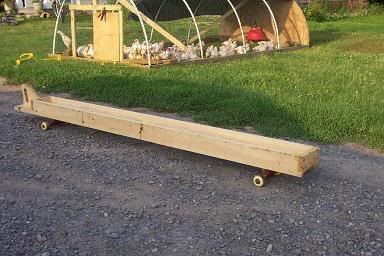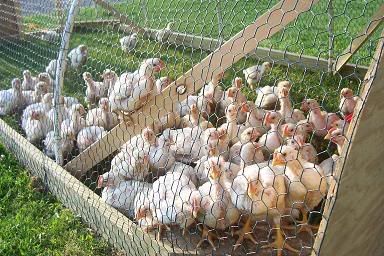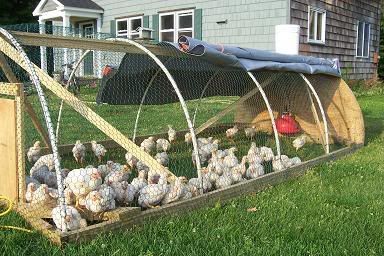Dateline: 5 August 2007
It was a year ago this month that I blogged a photo essay here titled, Talkin’ Bout My Chicken Tractor. I introduced the practical virtues of my eight-year-old homemade chicken tractor. That old tractor (now 9 years old) is looking shabby but it's still perfectly functional and currently serving to hold five turkeys. Since I’m now raising turkeys in a tractor, I needed to build another for the chickens. Here’s a picture of my newest chicken tractor:

If you read my previous chicken tractor blog, you will notice that my new unit looks a lot like the old one. That’s because the old style has served me so well. But I have made a few changes and I kept track of my expenses too.
One difference between my old and new chicken tractors is that the new one is a foot wider. It measures 6ft by 12 ft. The hoops are 3/4” pvc water pipe, just like on the old version but the wider frame means this new tractor is lower in the center. The center height is 40.”
Another difference is that I made the closed end out of 1/2" CDX plywood instead of waferboard (a.k.a., Oriented Strand Board). CDX plywood is made with exterior glues and will not rot out as quickly as waferboard.
When making my new tractor I moved the Plasson bell waterer a few inches nearer to the door on the closed end. Now it is easier to access for cleaning.
I left the 10 inch wheels off the tractor and put a rope for moving on each end. I’m the one who does the moving and I have no problem lifting a bit and pulling one side of the unit over, then the other. In other words, I move it sideways, one end at a time. It’s not as easy as moving ahead with the tires, but its no strain for me to shuffle it over. I might bolt on tires someday.
I opted to leave off the pvc drain pipe side feeders. They worked okay but I could not clean them without climbing into the cage. And filling them with feed by pouring it through the chicken wire was not an ideal situation. My newest idea for a feeder is pictured here:

What you are looking at is a long trough with skateboard wheels under each end. And there is a wooden handle on one end. My newest chicken tractor now has a removable hatch on the end opposite the door (you can see it in the picture). I fill the trough with feed, open the hatch, and roll it in. I reach in and remove the feeder for reloading and when I want to move the cage. This new feeder isn’t a perfect solution but I do think it is an improvement.
The only other change I made was to put furring strip angle braces on both ends of the tractor, instead of just one. Here’s a better view of one brace:

It is those braces, in conjunction with the furring strip ridgepole, and the 2x4 angle braces (2ft long) on each corner of the 2x4 pressure treated bottom frame, that give this tractor amazing structural strength. Furring strips are light weight, strong and cheap wood pieces. I purchased a bundle of ten furring strips at 12 ft long for this project. The bundle cost me $20.37. There were some knots in the wood but I was able to pick and choose, cut and utilize, and ended up with wood pieces that had enough integrity to do the job nicely
I kept track of my material costs for this new tractor. Excluding the waterer, the total cost of materials (including 8% NY state sales tax) was $168.24. This tractor should have at least a ten year functional lifespan. So that figures out to $16.82 a year for pastured poultry housing. I currently have 66 Cornish X chickens in this tractor. That’s okay when they’re little. But as they are getting bigger, I need another tractor. My next chicken tractor will look just like this one. That’s how pleased I am with this design.
=============
One more thing. As some of you already know, I “pasture” my meat birds on my overgrown front lawn. Here’s a picture to prove it:

The front lawn serves as a pasture because we are working with very little land here. Fortunately we do not have any close neighbors to complain. That’s one of the nice things about living in the country. You have more freedom.
There are advantages to raising chickens in your front yard. One is that the garden hose will reach the tractor. This makes filling the water bucket and cleaning the waterer real easy. And you don’t have to walk far to feed the little critters. And you can keep an eye on them better.
The only real disadvantage to front yard chicken tractors is the manure. As the birds get bigger, the manure deposit gets heavier, even when moving the cage twice a day, as I do. My kids do not like the manure because the front yard is where they do a lot of their bike riding, football playing and so forth.
But the manure lasts only a few weeks, and sometimes it has its advantages. For example, my boys recently set up a bike jump in the front yard. The jump was nothing more than a length of 2x8 board angled up on a chunk of firewood. They, and a couple of neighbor boys, took turns riding their bikes down the road, into the front yard, off the ramp and onto the front lawn. They were filming their exploits with a video camera. One of the neighbor kids sailed off the ramp, wiped out, and hit the ground, rolling headlong onto a patch of chicken manure. It was all on video. It wouldn't have been such a "precious moment" without the chicken manure. Just the thought of watching that film clip makes me laugh.
==========
If you liked this essay, I invite you to check out my Blog tutorial, How To Butcher A Chicken
==========























































































































29 comments:
Herrick, I am trying to see the hatch you talked about. Is it the end that is totally wood?
Hi marci,
he removable hatch is on the opposite end of the solid plywood. You can see it on the right side of the first picture. It's held in place with a spring clamp at the top and easily removes for sliding the feeder in.
By the way, I should have also pointed out that I used vinyl coated poultry fencing for this newest tractor. My older tractor has galvanized chicken wire which has become very rusted after 9 years.
So, is the hatch, the large piece of wood on the right end of the first picture? I was thinking a small door like chicken size, just big enough to roll the feeder through.
Yes. That is it. Maybe I should not have called it a hatch. It is more of a removable panel. It needn't be so big.
What is the length of the ¾" pvc pipe?
aquismoney--
I believe they were 10ft from the store and I cut them a little shorter in order to match the curve of the plywood end, which I cut out and nailed in place prior to putting the hoops on.
Hello Herrick,
I'm interested in duplicating your tractor design for myself. It isn't a complicated design, but I was wondering if you would ever be willing to make plans availible for others to follow.
As an aside, I used your picker book and parts from your workshop to build by own picker. It works great! Thanks very much.
I cant clearly see how the top brace is attached to the ends. I have 2 very similar coops I built that are simply a rectangle of wood on the ground, and I used old field fencing for the hoop, no braces of any kind. maybe 6x8? I cut end pieces (including hinged door) out of the fencing and wired them all together. I have one 1x2 that goes from bottom to top on each end, but slanted, not straight up and down, and attach straight to the wire. very sturdy, but not around the bottom. my problem, is I cant figure out how to put the end pieces together, or fit the wood together at the top so they are sturdy enough to be moved regularly. I have a hard enough time building a good square or rectangle..alas, although I try, I am just not construction inclined. on a positive not, I can say, the only cost was the roll of 6mil opaque window plastic I used to cover it. everything else was scrap I had lying around.
anyway, could you post a close up of the 2 ends, inside and out so I can see how it all attaches?
also, I am more interested in using these for layers rather than meat birds. what do you think would be the space requirements for them?
thanks
amanda
Herrick,
At night you lower the tarp on both sides making--if I have my math right-- a three(?)-sided shelter.
If I'm a raccoon and I can still SEE chickens in there, it seems that's only going to strengthen my infamously diabolical coon resolve.
And I don't see any "roosts" either!
All the reading I've done trying to get up the guts to build an actual "coop" places high marks on at least half of them having a place to sit.
Maybe I'm confusing layers with broilers... How long are your chickens in this contraption?
Thanks! Love the blog. You didn't have to share, but you did.
--
David
Hi. Thanks for sharing. I am admiring your design, but am concerned about predators... especially of the coon variety. Does that vinyl coated chicken wire prevent them? I've heard they can rip right through chicken wire if they are motivated... and I'd hate to lose my babies to the coons and coyotes that patrol our area at night!
I seem to recall one of your other blogs mentioning a dog... for those of us who are dog-less, does your design afford enough predator protection? or would we need something more heavy duty?
Thanks,
Bernadette
David,
The Cornish X meat birds are not big on roosting once they get a little age on them. If I had egg layers in the cage I would provide roosts.
Bernadette,
There are plenty of coons hereabouts. If one of them (or a coyote) really wanted to get through the chicken wire, I'm sure it could. But it would not be an easy thing do do. Chicken wire is tough stuff. It's been used for a long, long time to keep predators out. It's not likely that a coon is going to go to the trouble. There are easier sources of food in the wild. What is more likely is that a weasle or mink or rat may get under the bottom of the frame if there is a little space. That is what we have had happen.
The dog is good to have but not necessary. Our dog is not always out there at night.
I love chicken tractors. I built one just like the one in the Chicken Tractor book, but it is heavy and hard to move around because the end drags against the ground. Also, the huge lid allows birds to escape if they choose when you open it, and being 3' high it's too deep to reach down into comfortably and too short to get into to work in comfortably. I built a second one the same footprint (4 x 10 I think? maybe 4 x 12) but only 18" high plus another 18" high covering 1/3 of one end, with roosts and a nest box. At least when I opened the lid the birds would run under the high part instead of flying out, but if I needed to catch them I had to squat way down and close the lid over me, crawling through the poop to get at them under the high part :-D
My last two hoop coops have been built along the style of Robert Plamondon www.plamondon.com/hoop-coop.html. Approx. 9 x 9 and 6' tall, very sturdy using cattle panels as the hoops and best of all you can walk in without stooping. In the winter I put them up on a foundation of straw bales and butt them up against the small shed that used to be my only chicken house, thus tripling their previous winter area. I got that idea from http://sugarmtnfarm.com/blog/, under his "favorite posts" look at Winter Chicken Coop, Chicken Sunroom, and Wire Hoop Coop. (The internet is a wonderful thing!) We had very heavy snows the past two winters, and though the panels will bow way down under the snow load, they spring right back up again when the snow is dragged off them.
Cattle panel price has gone up considerably, thank goodness I still have a few left because I want to build two more. They are heavy but a little easier to drag than the original tractor because the end boards are raised slightly off the ground, which turns the side boards into skids. Instead of doing it Robert's way with the frame boards all on their narrow sides and notched at the ends to fit together, I just lay the side boards flat and the front/back boards on their narrow sides, which has the same effect of leaving a 1-1/2" gap front and back making it easier to drag.
I asked on a poultry message board about pluckers for the small home user and rec'd numerous replies that yours was the best. I just ordered both plucker and scalder books and look forward to building them, or making my husband do it if it's beyond my extremely limited crafstmanship :-D
Karen B in northern Idaho, where it seems like winter will never end this year
No wheels here and I am an old lady. I use a furniture dolly to move my tractor around. Just slip it under, lift (a little otherwise I get escapees), and pull. If it is in high grass my neighbor lady helps me with another dolly on the other end. Raccoons aren't my problem here so much as possums. As I tell my granddaughters; anything with hands can steal. Those buggers have four hands! Possums are smarter than raccoons and more daring. Once had a baby duck taken out of a dog cage .. through the wire! The same gal even tried to steal a eight pound file box of cat food. She went to heaven. But, so far no varmit has gotten into my tractor. They go after my lone ducks. I just quit keeping ducks. Didn't like eating them anyways.
Rustyoldma@yahoo.com
NE Ohio
BTW, Thanks for teaching me everything I've been doing wrong in butchering chickens, specially necks. Too many times I've cooked up a roast and found I missed the lungs ... yuck!
Hello,
I was wondering if your tarps wear out? I have a haystack that we tarp and we have to replace them every year, so I don't want to have to spend that much money on the tarps for the chicken tractor every year.
Thanks for all your info!
Andrea
Andrea,
If you use the cheap plastic tarps, they will weather out in a year. If you use a slightly more expensive plastic tarp (like shown in the photos above) they will wear out in a couple of years. If you buy an expensive pvc-impregnated canvas tarp (like truckers use to cover a load of hay), it will last you more than ten years. I know this because I have used such tarps on other chicken tractors.
Best wishes,
Herrick Kimball
Do you put egg layers in these tractors as well? If so do you just put in a nesting area with access?
Herrick, Jim here from Ontario Canada. loving all of your postings! How have the Maggots worked for you? I have kept layers for a few years and meat birds only one season. I will be building a tractor soon. Thanks for all of your information! God bless you brother!
Herrick,
Thank you for all the information you posted on your chicken tractor. It is very helpful. My son is a landscaper/CSA farmer in Southern Illinois and just started raising chickens. He has layers and just purchased his first "flock" of meatbirds. Of his many talents, one he lacks (and he will admit) is carpentry skills. So Dad is building the chicken tractor. He really likes your hoop tractor design (with the CSA he has one large hoop house and will be building another this year for his vegetables/produce). A couple questions I had about your design before I start: Was there a reason (and maybe I overlooked it) for not enclosing both ends with plywood? I know the cost would be more but I was thinking by doing so you could then pull the tarp from one to the other covering the entire tractor and elinimating the preditors actually seeing the birds. Forgive me if this next question seems odd but we are new at this, do chicken tractors have a wire bottom in them? I know you wouldn't be picking the tractor up high enough for the chickens to escape so they would basiclly be moved with the tractor. Thank you again Herrick for your posts, being a baby boomer from the country I grew up around farming/livestock where people depended on a cow/pig/chickens to feed their family. Being raised on "homeground and homecooking" is something the majority of our kids nowadays sadly miss out on. take care, Shooter
Hi Dave,
Both ends can certainly be covered with plywood. The reason I didn't do this i, as you say, to save money, but also to keep the structure as light as possible.
There is no bottom in these chicken tractors. I've heard of people putting a wire bottom in their tractors but it is very rare. The wire would hinder the chickens from scratching and getting food.
There are times, especially when the birds are small, that a few will sneak out under the edges when the tractor is moved. It takes some finesse on the part of the mover to manage esacpes.
Thanks for the questions. Best wishes with the project.
Anonymous,
I have used the chicken tractors for egg layers. Provide a nesting box or two off the ground on the plywood end. You can even have an open & shut door for access to the eggs from the outside.
Jim_
Good to hear from you. I must confess that I have not tried the maggot feeding method yet. Our space here is so small (I am raising chickens mostly on the lawn around my house) and we're thinking we'd rather not endure the smell of a rotting, maggot-infested woodchuck. perhaps when I get some more land, the idea will be more acceptable, especially to my wife. :-)
I have one question about the tractor. We are getting ready to build one. We have about the same size property as you, just over 1 and 3/4 acre. Currently our birds are in a fenced area and go into the coop at night. This spring has been so wet. Do your chickens sleep on the ground at night? What happens if it rains alot? Can an area under cover have a raised floor or something like that? What would happen if the ground was soggy all the time and they didn't have anywhere to get away from it? By the way I love your blog and all the wonderful info. It is awesome.
Thanks again for another helpful and idea inspiring entry. We have been looking to make some sort of hoop tractor for our birds for a bit. We tried the a frame (and though it looks nice, its rather limited and heavy, so a hoop would be perfect. A question on sizing though. Is there a reason you didn't go bigger? We have a bunch of turkeys to contain and were leaning towards something more like 10 x 20. we have a small sllooowww tractor that should be able to move something like that just fine. Any thoughts?
thanks
Sib
Anonymous-
I see no reason why you couldn't employ the same basic idea and "supersize" my basic chicken tractor design. Mine is the size it is because I don't have a lot of chickens, a lot of space, or a tractor. It is a size that I can manage to move by hand with relative ease. I have employed the tractor to raise turkeys, though not a lot of them in each tractor. I have a blog post about the turkeys in tractors somewhere.
Best wishes,
Herrick Kimball
We are starting construction this week. We spent the last little bit scrounging parts and redesigning to make it as much re-purposed material as possible. So far all i've had to buy are the brackets and PVC pipe. we have the lumber and some fencing laying that we can use as well as the small hardware we'll need. As for feeders i think i will just make tripods for my hanging feeder/water to hang from. should be no big deal to move them that way and they wont be able to roost on them. As for the size, we have a 23 acre farm so that's not an issue and we have 30ish turkeys that need to be contained in the worst way. We'll still let them out, but for the times we cant watch them and at night, in they will go! I can send you photos when we're done if you like?
Thanks
sib
sib,
I'd love to see pics of your completed hoop tractor. Send to: hckimball@bci.net
Do you mind telling us how you have the 5 gallon bucket supported?
Thanks!
Herrick,
Just wondering how long the pvc pipes are? This looks like a great plan and we're going to build one this week.
Thanks for some great posts!
Dave, Thunder Bay, Ontario
I am new to the chicken world and am finding a lot of useful info on here, Thanks! I am glad you mentioned in the posts as to why you didn't put wire at the bottom, because I was seriously thinking about doing that because it seemed ideal in keeping predators out. We have a lot of racoons around.
Thanks,
Liz M
Google black soldier fly larvae bin. You can raise them with out rotting carcasses. Very neat, and the larvae repel other flies.
Post a Comment